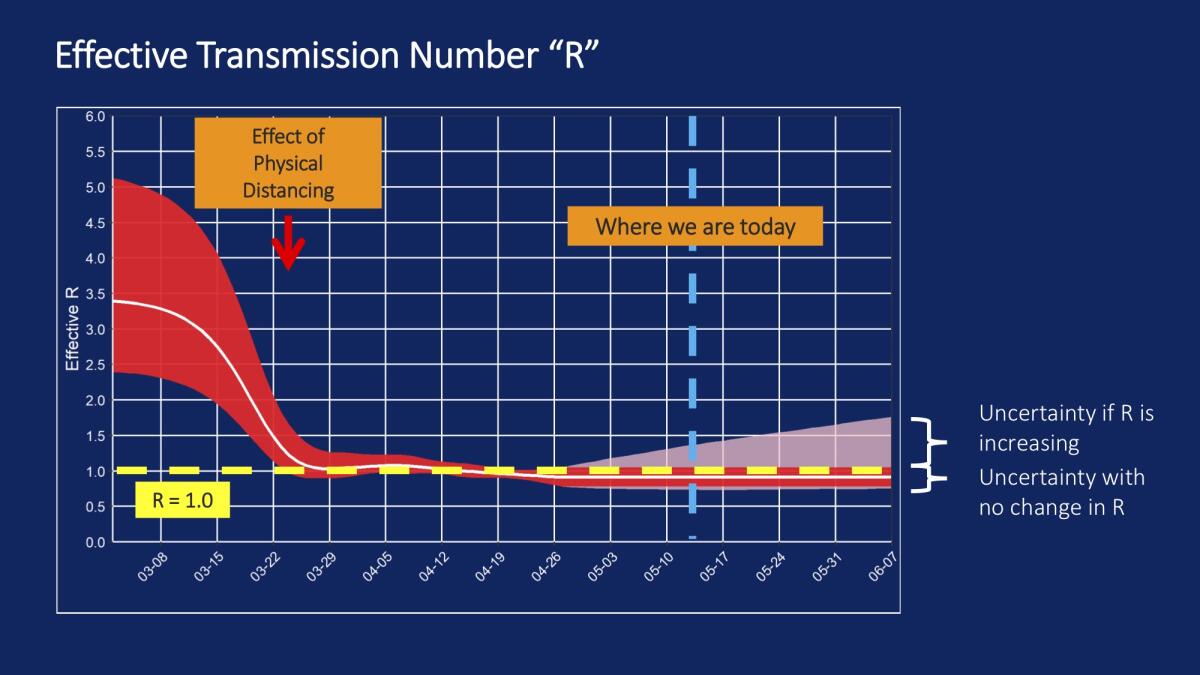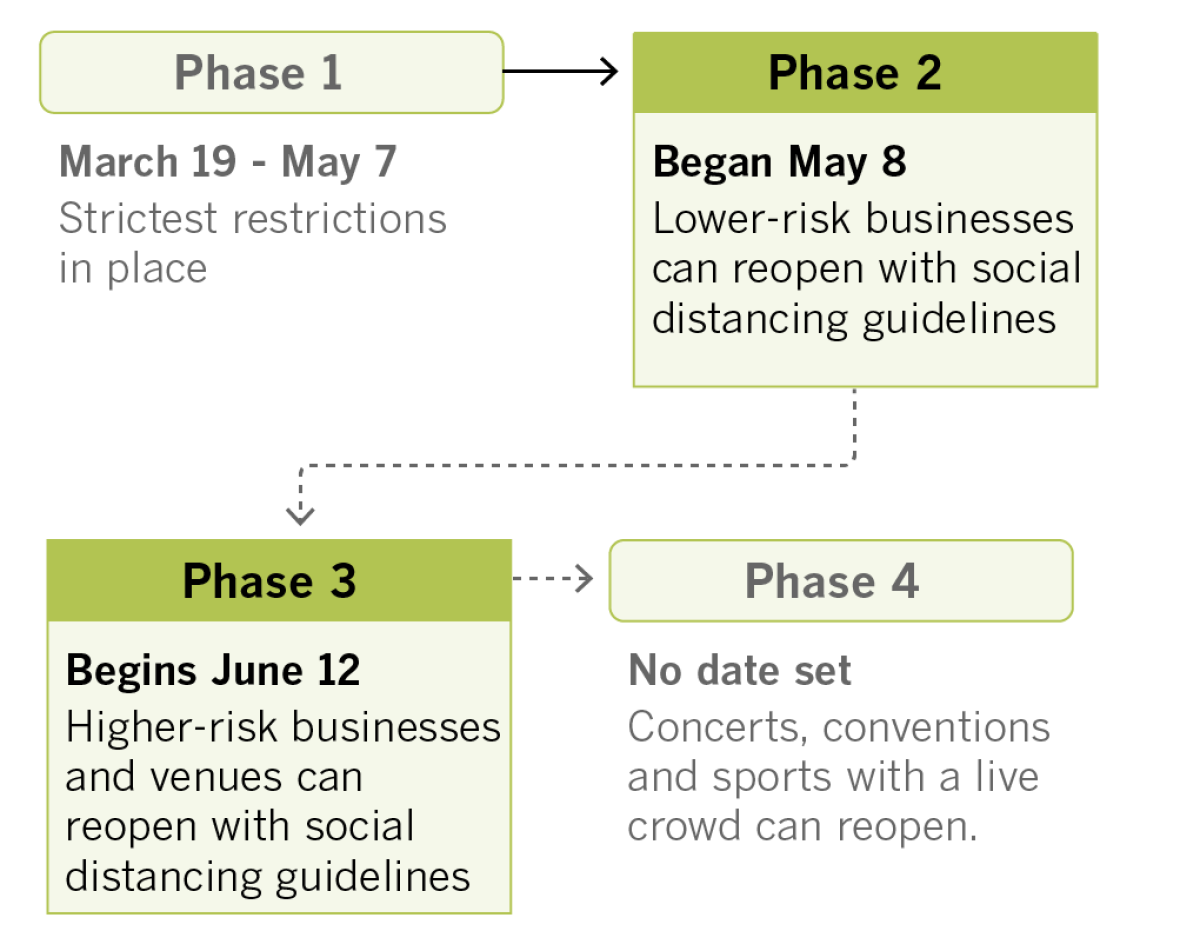Coronavirus Today: Learning as we go
- Share via
Good evening. I’m Diya Chacko, and it’s Monday, May 18. Here’s what’s happening with the coronavirus in California and beyond.
Nearly nine weeks after the state stay-at-home order was put in place, Gov. Gavin Newsom on Monday announced a major loosening of the criteria for allowing counties to proceed with the second stage of reopening. Previously, counties could not progress unless the number of COVID-19 deaths dropped to zero and the number of new cases fell to 1 per 10,000 residents for 14 days straight. The new standards allow 25 newly confirmed coronavirus cases per 100,000 residents and eliminate the zero-deaths standard. Under the new rules, roughly 53 of California’s 58 counties could move forward.
Though the state’s case count is beginning to taper off in rural regions, the virus continues to spread in more urban areas. That’s leading to a confusing mix of restrictions to navigate when traveling between cities and counties. For example, while Los Angeles County accounts for the bulk of California’s coronavirus cases and deaths, some cities within it, such as Santa Clarita, Lancaster and Palmdale, have been less affected by the virus — and they have asked for permission to reopen more fully.
In early March, each person in L.A. County who tested positive for the coronavirus went on to infect 3½ other people, on average. Now that figure, known as the Effective Transmission Number, or “R,” has dropped considerably. Since the end of March, after stay-at-home orders and social distancing protocols went into effect, each infected person in L.A. County has spread the virus to just one other person, on average.

While public health experts tout California’s progress in slowing the virus, they’re still worried that reopening the economy may lead to a surge of new cases in the coming weeks, as symptoms emerge in people who are just now becoming infected. L.A. County will need to closely monitor the rate of disease spread, said Dr. Christina Ghaly, director of health services, because if people don’t practice social distancing or stop wearing masks, the Effective Transmission Number may start to rise once again.
As scientists race toward developing treatments and a vaccine, the National Institutes of Health is embracing a more flexible approach to conducting research with adaptive clinical trials. They’re sometimes called “learn as you go” trials because they allow early results to shape the next phase of the research. But while they may help scientists speed the pace of discoveries, the trade-off is that they’re not considered as scientifically rigorous as the traditional randomized controlled trials that regulators have relied on for decades to weed out useless and potentially dangerous drugs.
By the numbers
California cases and deaths as of 3:00 p.m. PDT Monday:
Track the latest numbers and how they break down in California with our graphics.

See which counties are reopening with our tracker.
Across California
Even as they file lawsuits to overturn California’s stay-home orders, a number of churches are being blamed for new coronavirus infections across the state. A Mother’s Day service may have been the vector for a cluster of cases in Mendocino and Lake counties, where infections have otherwise been low. In San Diego County, churches in Chula Vista and Oceanside held services where few people wore masks or stayed six feet apart, video shows.
Many restaurants struggling to stay in business have slammed delivery app companies like Postmates for gouging them with fees that can reach as high as 30%. The L.A. City Council is considering a proposal to cap those fees, but other restaurants fear a limit will just force delivery companies to compensate by cutting services, docking their drivers’ pay or charging diners higher fees.
The City Council is also looking into helping the merchants on Olvera Street who sell handcrafted items such as pottery, candles and Mexican folk art in one of the oldest neighborhoods of Los Angeles. Tourist foot traffic has vanished as restrictions prevent people from gathering at the marketplace. A member of the Olvera Street Merchants Assn. described it as “90 years of our legacy gone because of 90 days of hardship.”
Joshua Tree National Park partially reopened to the public Sunday, allowing visitors to use parking lots, trails, family campsites and some bathroom facilities. Visitors centers and group campsites will remain closed, officials said, and loop trails only allow one-way traffic.
Resources
— For general safety, wash your hands for at least 20 seconds (here’s a super-fun how-to video). Stop touching your face, and keep your phone clean. Practice social distancing, maintaining a six-foot radius of personal space in public. And wear a mask if you leave home. Here’s how to do it right.
— Watch for symptoms including fever, cough, shortness of breath, chills, repeated shaking with chills, muscle pain, headache, sore throat and loss of taste or smell. If you’re worried you might be infected, call your doctor or urgent care clinic before going.
— Here’s how to care for someone with COVID-19, from monitoring their symptoms to preventing the virus’ spread.
— If your job has been affected by the coronavirus pandemic, here’s how to file for unemployment.
— Here are some free resources for restaurant workers and entertainment industry professionals having trouble making ends meet.
— Advice for helping kids navigate pandemic life includes being honest about uncertainties, acknowledging their feelings and sticking to a routine. Here’s guidance from the Centers for Disease Control and Prevention.
— In need of mental health services? Here are resources for coping during the crisis from the CDC and the L.A. County Department of Public Health. L.A. County residents can also call (800) 854-7771 or text “LA” to 741741.
Around the nation and the world
The Dow Jones industrial average leaped nearly 1,000 points Monday on the early results of a COVID-19 vaccine trial reported by Moderna. But don’t get too excited, writes business columnist Michael Hiltzik. While evidence that the trial vaccine produced antibodies in humans that protect against the coronavirus in the lab is encouraging, it doesn’t yet warrant terming the vaccine a success. The drug still needs to undergo broader testing and its actual protective effect needs to be measured. Then there’s the challenge of manufacturing any vaccine that has been approved and distributing it broadly enough to secure widespread immunity.
President Trump claimed on Monday he was taking the antimalaria drug hydroxychloroquine to protect himself from the new coronavirus. The drug is unproven in fighting COVID-19 and has the potential to cause significant side effects in some patients.
The nation’s hardest-hit city, New York, saw a decline in its daily rate of new hospitalizations, Mayor Bill de Blasio said Monday. While he called it “a wonderful sign,” he also cautioned that the city won’t be ready to start relaxing its social-distancing restrictions until the first half of June at the earliest.
Data coming out of Georgia over the past month seemed to show the state had completely flattened its coronavirus curve prior to an aggressive reopening of its economy. But an investigation from the Atlanta Journal Constitution revealed that officials drastically misrepresented the numbers. “If the numbers look too good to be true, they probably are,” writes our digital opinion editor Matthew Fleischer. “Don’t let politically motivated talk of reopening lull you into a false sense of security.”
“Minecraft,” the online game known for its creative use of blocks and monsters that come out at night, has offered teachers a way to engage children even before the pandemic forced classes into virtual spaces. Now Microsoft, which owns the game, reports that it’s been downloaded more than 50 million times since it made “Minecraft’s” educational tools free on March 24. Fittingly, virtual graduation ceremonies within the game are taking place around the globe.
Your questions answered
Today’s question comes from readers who want to know: When can we see our friends? Science reporter Deborah Netburn asked experts how to assess the risks of meeting people in real life.
The relative risk of seeing others depends on a few factors, such as the prevalence of the disease is in your community and how much potential exposure the friend or family member you plan to see has had to the virus. “The idea of safe or not safe is not black and white,” one health expert said. “It’s a degree that is influenced by multiple factors.”
In a scenario such as a taking a socially distanced walk outside, for instance, the risk is relatively low. If you’re having a family gathering in a backyard, however, the risk can be higher — especially if children are present playing together.
The general rules of thumb to consider are:
— Outdoors tends to be better than indoors;
— Small groups are better than large groups;
— A shorter period of time is better than a longer one.
And of course, we can further reduce the risk of transmission by washing our hands and wearing masks.
Got a question? Our reporters covering the coronavirus outbreak want to hear from you. Email us your questions, and we’ll do our best to answer them. You can find more answers in our Frequently Asked Questions roundup and in our morning briefing.
For the most up-to-date coronavirus coverage from The Times, visit our homepage and our Health section, listen to our “Coronavirus in California” podcast and follow us on Twitter and on Instagram.





